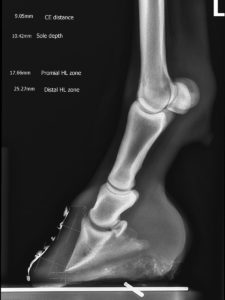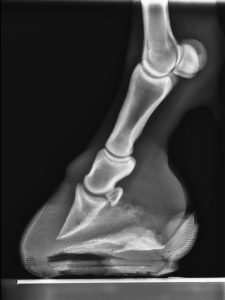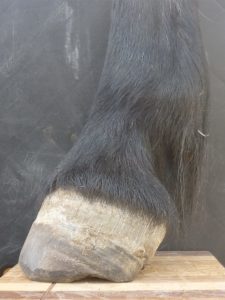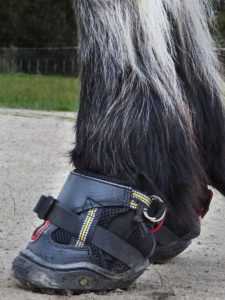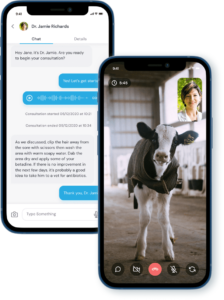Ginny presented with a Grade 2 Obel lameness.
Ginny presented with lameness in both front hooves (Grade 2 Obel lameness scale), bounding digital pulses and a history of intermittent laminitis.
Bloods were taken to check for for Insulin Dysregulation and Pars Pituitary Intermedia Dysfunction* (PPID – also known as Cushings disease). Insulin levels were high, indicating that the current diet was too high in sugars, and ACTH levels were also high suggesting PPID.
There were several other clinical signs that were also consistent with PPID. Ginny was drinking and urinating slightly more than usual, had mild conjunctivitis and a thick coat.
An appropriate diet based on tested low sugar hay with appropriate supplements was fed and pergolide (Prascend tabs) started.
Hoof care was started with a trim utilising the radiographic information and then Epona shoes and a cast were applied. This shoe/cast combination is extremely helpful when there is a lack of lamella connection, as the cast provides rigid support to the foot, and the packing under the shoe spreads the weight between structures in the caudal part of the hoof. It also allows an appropriate break-over to be put in, without overloading the sole under the tip of P3. This shoeing combination provided rapid relief of pain and in combination with the dietary changes meant she was able to walk normally within days.
This shoeing combination was repeated twice more (6 weeks each) and the shoes were then removed. During this time, additional bloods were taken to check the pergolide treatment and more dose increases made.
Because the hoof was supported with the cast and shoe, Ginny was able to be ridden lightly during this time.
This photo clearly shows the new tighter growth of hoof wall growing down from the coronary band. This tighter growth represents the time she spent in the shoe/cast combination (12 weeks).
After this time, Ginny was allowed to go barefoot with regular trims.
Ginny has required regular increases in her medication which can be common for horses with PPID*.
Although Ginny is now sound and working happily, she will continue to require medication for PPID and a low sugar diet for the rest of her life. Although we can prevent more laminitis, we can only treat the PPID and try to keep it under control. Ginny is barefoot in the paddock but wears boots with pads to dissipate concussion while working.
*PPID is a neurodegenerative disease in the pars intermedia part of part of the pituitary gland (brain). Normally, the cells of the pars intermedia (melanocytes) are controlled by dopamine. In PPID, there is a loss of dopamine which means the melanocyte cells start getting bigger and bigger (hypertrophy). These enlarged cells then produce peptides in greater amounts than normal. These peptides are then converted to various hormones – one of which is ACTH (which is what is measured on blood tests). Not all horses with PPID have the same symptoms, as there are various pathways and hormones which can become out of balance.
There is no sex or breed predisposition for PPID, but an increase in age is associated with an increased risk.
A positive PPID diagnosis makes laminitis more likely.
